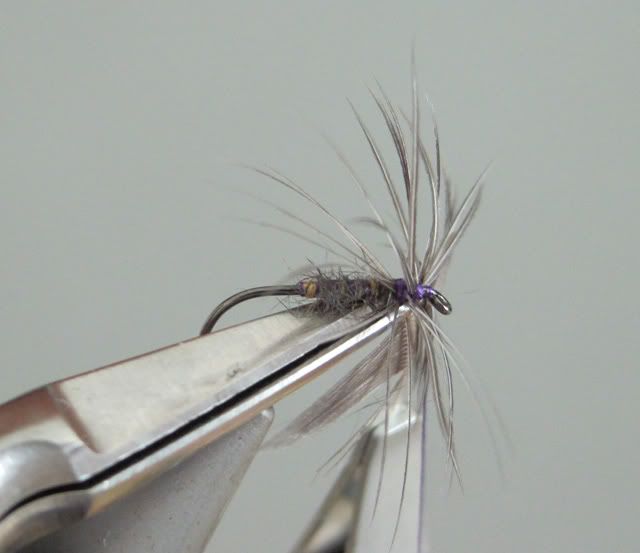All this talk of spiders got me going and with Iains abuse of the snipe and purple, i was thinking perhaps i'll share my variation on the Dark Watchett

This is the best place for the SBS's so i thocht i'd put it here.
NOT an entry mind

Hook: Partridge SLD size 14
Thread: Pearsalls no.8
Hackle: The outer covert of a Coot (moorhen is too green, the original calls for jackdaw throat, if you have one

, coot is as close as i get)
Body: A length of Pearsalls no.6a and some natural mole hair.
Step 1. Place hook in vice.

Step 2. Take wing and select an appropriate feather.

Step 3. Remove flue from base and Check it for length, the fibres should be the length of the plain shank of the hook.

Step 4. Start thread 1 turn back from eye and make approx 3-4 turns. Trim the tag end.

Step 5. Take the feather and stroke back the fibres and tie in the feather by the tip, again 3-4 turns and trim the tip.

Step 6. Tie in length of orange silk (6a) and wrap back to inline with the point of the hook.

Step 7. Twist the orange and purple silk together, so it is nicely varigated.

Step 8.
Lightly apply a nice sticky wax, to the twisted section.

Step 9. Take a small pinch of mole hair.

Step 10. Lightly touch the waxed thread with the mole fur , keep it very sparse but even.

Step 11. Wind the dubbed thread up to about 3 turns of thread before the hackle. And trim the loose end of orange silk. You should get a nice mix of the purple and the orange showing through the mole.

Step 12. Make 2 turns of the hackle from the front, back towards the thread and tie in the hackle.

Step 13. Make two turns of thread to secure and remove the rest of the hackle stalk.

Step 14. Wind thread thread through the hackle carefully, stroking the fibres so none get trapped or folded backwards.

Step 15. Gently hold the fibres back from the eye and bring the thread forward to the head area, don't tie the fibres down, just bring the thread forward.

Step 16. Form a neat head with 3 or 4 turns of thread and then a small whip finish. Stroke the fibres forward so they are perpendicular to the hook then varnish the head carefully with a drop on the tip of a needle so it soaks into the the thread and doesn't wick up the fibres of the hackle.

There you have it the finished Dark Watchett, one of my personal favourites for the Don in spring and autumn. Its best as a middle dropper fly.

Sandy
ps. The original Dark Watchett has the silk the other way round, with the main thread being Orange and the purple is used only for the body. I fancy this as an olive imitation rather than the iron blue, but thats personal preference. Thanks for reminding me Irvine


Tell you what though, this bloody camera doesn't half show up the flaws in what look like perfect little flies


